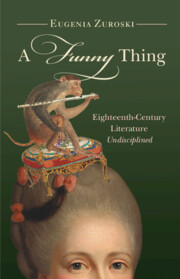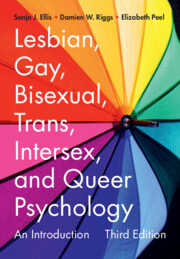Refine search
Actions for selected content:
139 results
Chapter 1 - The Bloomsbury Friction
- from Introduction
-
-
- Book:
- A History of the Bloomsbury Group
- Published online:
- 09 October 2025
- Print publication:
- 23 October 2025, pp 3-16
-
- Chapter
- Export citation
Chapter 30 - Ecology
- from Part V - Afterlives and Future Fields
-
-
- Book:
- Michael Field in Context
- Published online:
- 03 October 2025
- Print publication:
- 25 September 2025, pp 288-296
-
- Chapter
- Export citation
Chapter 14 - Whym Chow: Flame of Love and Animal Poetry
- from Part II - Forms and Genres
-
-
- Book:
- Michael Field in Context
- Published online:
- 03 October 2025
- Print publication:
- 25 September 2025, pp 123-132
-
- Chapter
- Export citation
Chapter 5 - Queering the House Beautiful
- from Part I - Works and Days
-
-
- Book:
- Michael Field in Context
- Published online:
- 03 October 2025
- Print publication:
- 25 September 2025, pp 39-47
-
- Chapter
- Export citation
Beneath the Oprichnik’s Brocade: Investigating Tchaikovsky’s Queerest Opera
-
- Journal:
- Cambridge Opera Journal , First View
- Published online by Cambridge University Press:
- 24 September 2025, pp. 1-21
-
- Article
-
- You have access
- Open access
- HTML
- Export citation
Chapter 22 - Lesbian
- from Part III - Culture, Society, and Politics
-
-
- Book:
- María Irene Fornés In Context
- Published online:
- 27 August 2025
- Print publication:
- 07 August 2025, pp 242-253
-
- Chapter
- Export citation

Performing Female Intimacy in Japan's Takarazuka Revue
-
- Published online:
- 26 July 2025
- Print publication:
- 28 August 2025
-
- Element
- Export citation
7 - Be Careful about the Publisher
-
- Book:
- Selling Sexual Knowledge
- Published online:
- 24 June 2025
- Print publication:
- 10 July 2025, pp 213-243
-
- Chapter
-
- You have access
- Open access
- HTML
- Export citation
Chapter 20 - The Formal Turn in Latinx Literature and Criticism
- from Part IV - Theoretical Turns
-
-
- Book:
- Latinx Literature in Transition, 1992–2020
- Published online:
- 19 June 2025
- Print publication:
- 03 July 2025, pp 367-385
-
- Chapter
- Export citation
Chapter 12 - Realism and Sexuality
- from Part II - Realism’s Keywords
-
-
- Book:
- Realism and the Novel
- Published online:
- 05 June 2025
- Print publication:
- 19 June 2025, pp 173-186
-
- Chapter
- Export citation

A Funny Thing
- Eighteenth-Century Literature Undisciplined
-
- Published online:
- 16 May 2025
- Print publication:
- 05 June 2025
How To Nurture Community Through Storytelling
- Part of
-
- Journal:
- Public Humanities / Volume 1 / 2025
- Published online by Cambridge University Press:
- 20 March 2025, e74
-
- Article
-
- You have access
- Open access
- HTML
- Export citation
12 - Globalizing European Gender History
-
-
- Book:
- Globalizing Europe
- Published online:
- 06 March 2025
- Print publication:
- 13 March 2025, pp 181-199
-
- Chapter
- Export citation
Queens of the Mother City: A Queer Investigation into the Roots of Cape Town’s Royals
-
- Journal:
- Cambridge Journal of Postcolonial Literary Inquiry / Volume 11 / Issue 3 / September 2024
- Published online by Cambridge University Press:
- 03 March 2025, pp. 298-316
-
- Article
-
- You have access
- Open access
- HTML
- Export citation
8 - Un-Gendering ‘Somewhere’
- from Part II - The Work Itself and Its Context
-
-
- Book:
- The Cambridge Companion to <i>West Side Story</i>
- Published online:
- 09 January 2025
- Print publication:
- 09 January 2025, pp 135-153
-
- Chapter
- Export citation

Lesbian, Gay, Bisexual, Trans, Intersex, and Queer Psychology
- An Introduction
-
- Published online:
- 12 December 2024
- Print publication:
- 12 December 2024
-
- Textbook
- Export citation
2.6 - Queerness
- from History 2 - Mechanisms
-
-
- Book:
- The New Cambridge History of Russian Literature
- Published online:
- 31 December 2024
- Print publication:
- 12 December 2024, pp 313-332
-
- Chapter
- Export citation
Picture-Reading the Complexities of Transgender Experience
-
- Journal:
- Canadian Journal of Philosophy / Volume 53 / Issue 7-8 / October 2023
- Published online by Cambridge University Press:
- 22 November 2024, pp. 600-609
-
- Article
- Export citation
Wer Viewership and Queer Imag(in)ing: Thai Soap Opera Shadow of Love and Boys Love Media
-
- Journal:
- TRaNS: Trans-Regional and -National Studies of Southeast Asia / Volume 13 / Issue 1 / May 2025
- Published online by Cambridge University Press:
- 11 November 2024, pp. 92-106
-
- Article
- Export citation
Chapter 13 - Gender
- from Part II - Social, Cultural, and Intellectual Contexts
-
-
- Book:
- Oliver Goldsmith in Context
- Published online:
- 28 November 2024
- Print publication:
- 07 November 2024, pp 104-113
-
- Chapter
- Export citation
